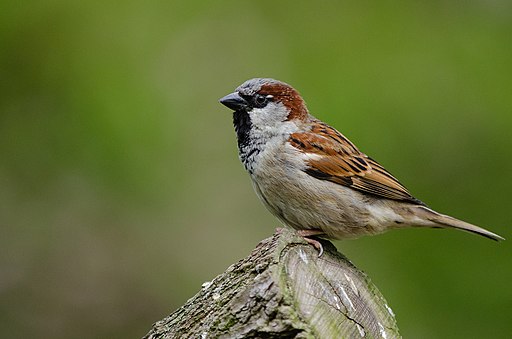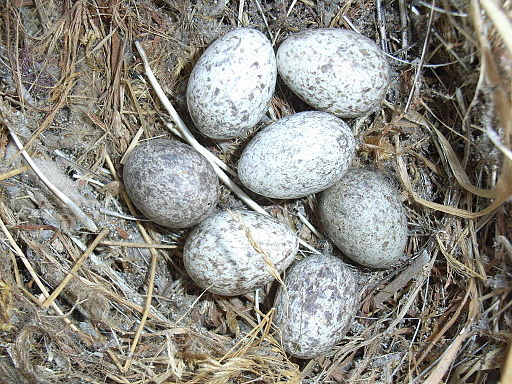 |
| House Sparrow by Mathias Appel / CC0 |
- Sparrows are small birds and can reach 4 to 8 inches in length and 0.8 to 1.4 ounces in weight.
- Sparrows can swim! They can swim very fast to escape from predators.
- Females lay 3-5 eggs and the incubation lasts 12-15 days. Both parents take care of the eggs and chicks. The fledglings leave the nest about 15 days after birth. The parents then have another brood. They usually have 2-3 broods per year.
- Sparrows survive 4 to 5 years in the wild. The oldest known wild sparrow was found dead 19 years and 9 months after it had been ringed in Denmark. In captivity they can live 12-14 years. The oldest captive sparrow lived for 23 years.
- The house sparrow was introduced to North America when a group of 100 birds from England were released in Brooklyn, New York. They are native to most of Europe, the Mediterranean region and much of Asia, and have been introduced to the Americas, Australia, and Africa. This makes them the most widely distributed bird in the world.
- House sparrows can live near humans and often do. They learned to eat when fed by bird feeders. They have lived beside humans since the Stone Age.
- Sparrows have a full chest and a large, rounded head. The males are a bit larger than the females. The males have a grey crown, black bib, reddish-brown back streaked with black and grey breast and belly. The females have brown, streaky backs and are buff below.
- They are very social. They even form flocks with other types of birds. They also roost together and are known to do some activities together including sing.
- They mostly feed on the ground. I definitely see mine mostly eating the food I drop on the ground.
- Their flight is continuous flapping and no gliding. They reach speeds of about 28.3 mph and about 15 wingbeats per second.
- They take dust baths. Often they will make small indentations in the ground and will defend their dust bath spot from other sparrows.
- They hop on the ground rather than walk.
- They do not migrate. They rarely move more than 1.2 miles from their birthplace.
- They mate of life and are monogamous. Their nesting season is from April to August. Male sparrows dominate over females during fall and winter and females dominate over males during summer and spring.
- Sparrows are a symbol of loyalty in Japan.
- When nervous house sparrows flick their tails to ease out the tension.
- Sparrows are meat-eaters by nature but have changed their eating habits when they learned to live close to humans. They primarily eat moths and other small insects as well as seed, berries and fruit. They added the seeds, berries and fruit because it was easier to eat when people “served” them food with birdfeeders.
- The male is responsible for building the nest. They try to attract the female during the nest building process. She will help with the rest of the nest building if she is interested. They often build their nests in cavities or ledges.
 |
| Clutch of House Sparrow Eggs by Notafly / CC BY-SA |
 |
| Female House Sparrow by Keith from Newark, DE, USA / CC BY |

Sparrow Nest at our house a few years ago
Sources:
Daily Journal. “5
Interesting facts about sparrows.” (8 May 2018) https://www.daily-journal.com/news/local/5-interesting-facts-about-sparrows/article_8b0891be-51f9-11e8-a35b-c3c7b79a56e1.html
Deepika. One India. “World
Sparrow Day: Little-known facts about Sparrows that will surprise you. (20 Mar
2018) https://www.oneindia.com/feature/world-sparrow-day-little-known-facts-about-sparrows-that-will-surprise-you-2662133.html
Justfunfacts.com.
“Interesting fun facts about house sparrows.” (2017) http://justfunfacts.com/interesting-facts-about-house-sparrows/
SoftSchools.com “Sparrow
Facts.” https://www.softschools.com/facts/animals/sparrow_facts/322/
Sparrow Crafts
I asked fellow bloggers for sparrow crafts and activities but no one shared any. I however have done some previously and made a felt sparrow to add to my collection.
I found the pattern for this felt sparrow at Downeast Thunder Farm. This is the house sparrow pattern but she offers other sparrows as well.
I also made a paper sparrow heart ornament which I actually made previously as well. I found the printable here. I also made these sparrows previously. You can also find more sparrow crafts in my Sparrow section of my Birds Pinterest Board. It has coloring pages, paper crafts, masks, crossstitch patterns and more!
Books Featuring Sparrows
I also found sparrows are in many books and the word sparrow is in even more. Here are some of the books I found to teach more about sparrows.






